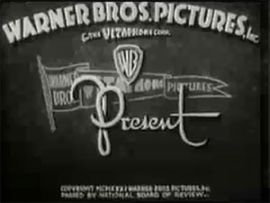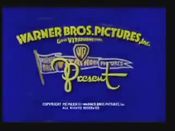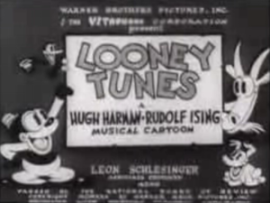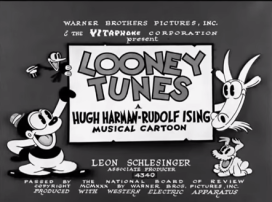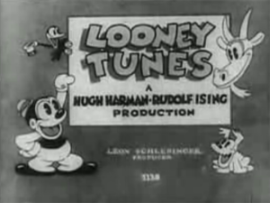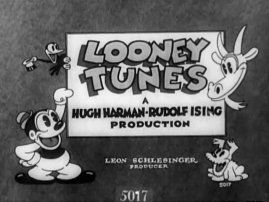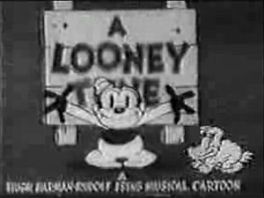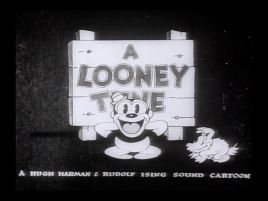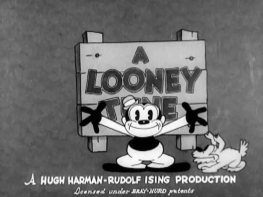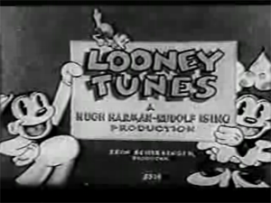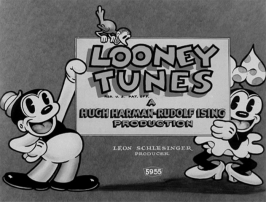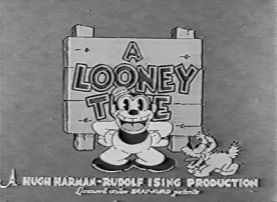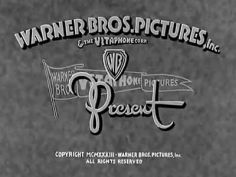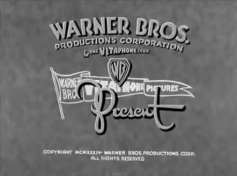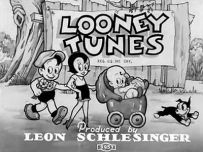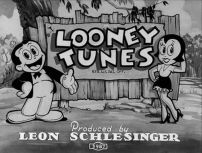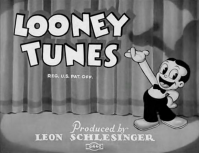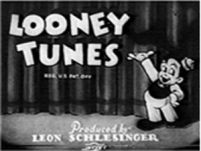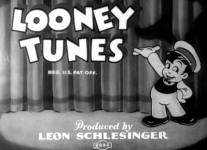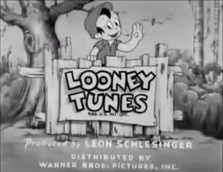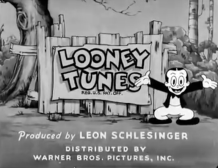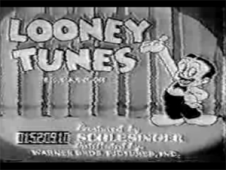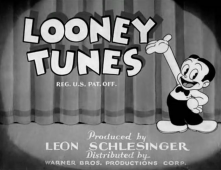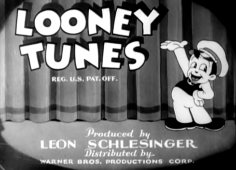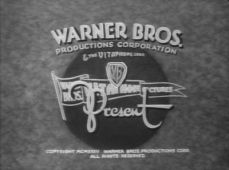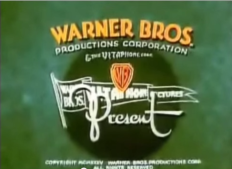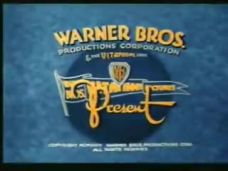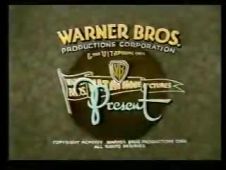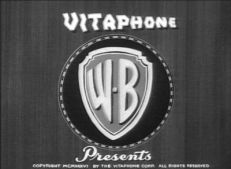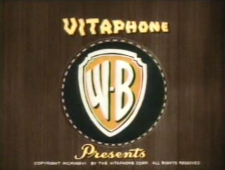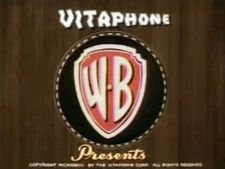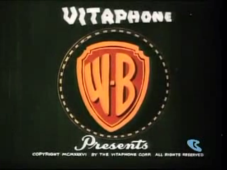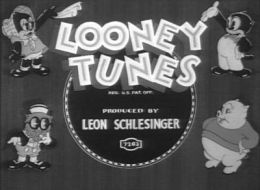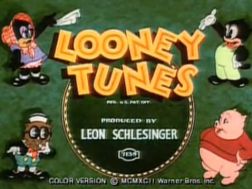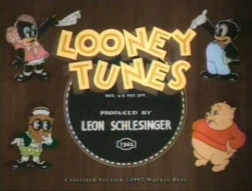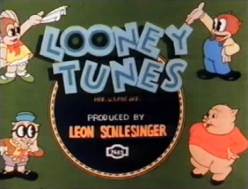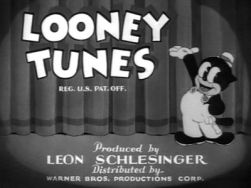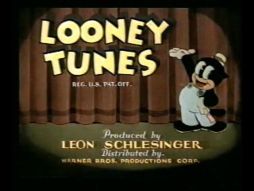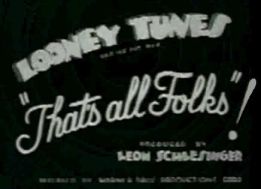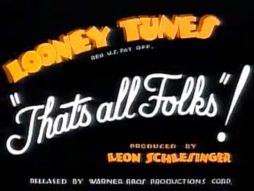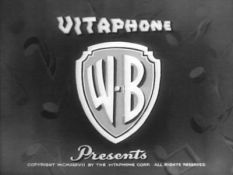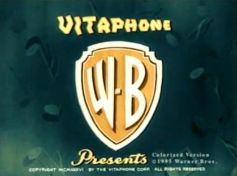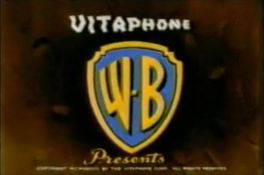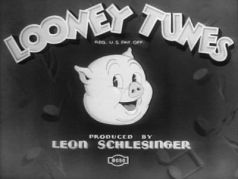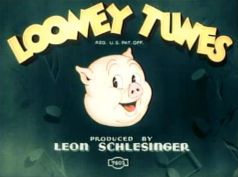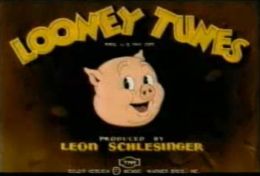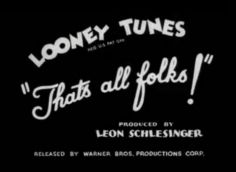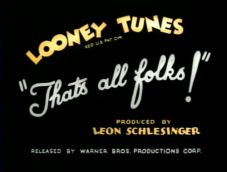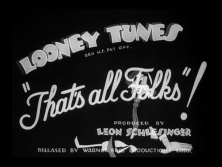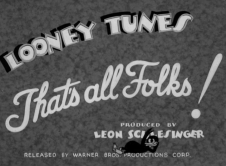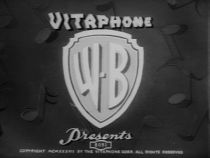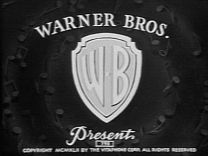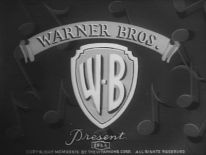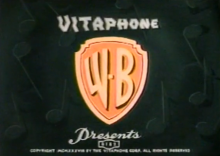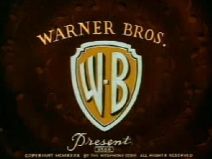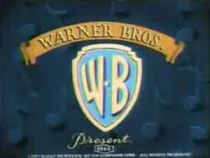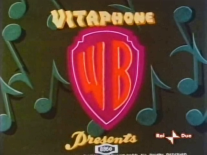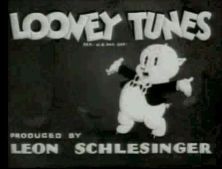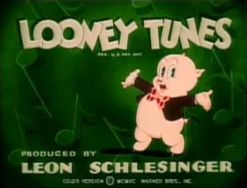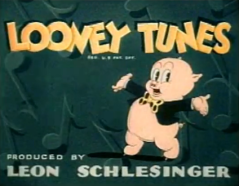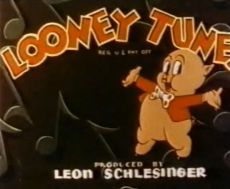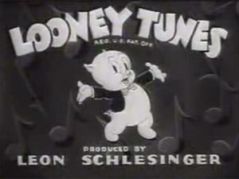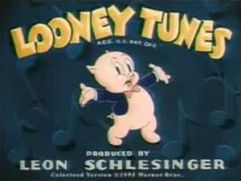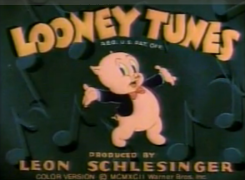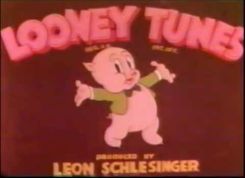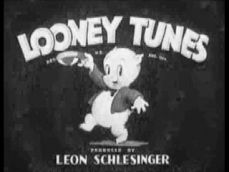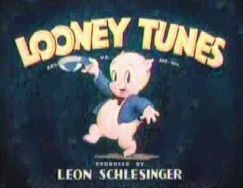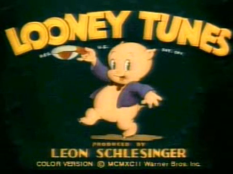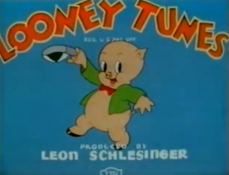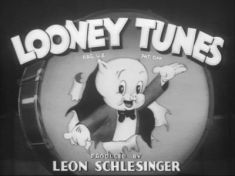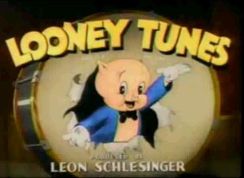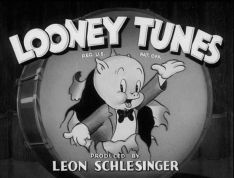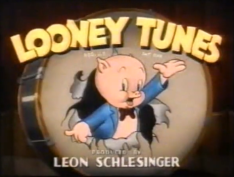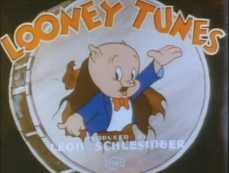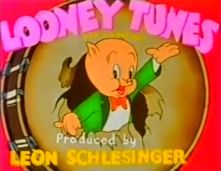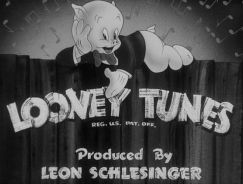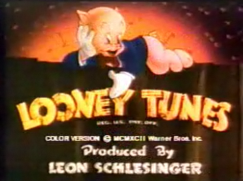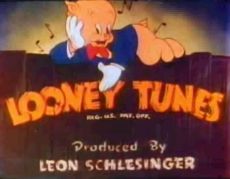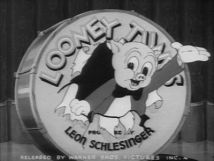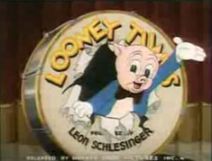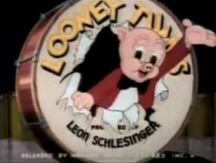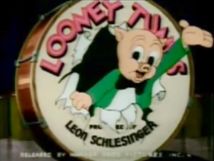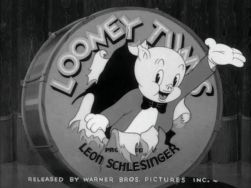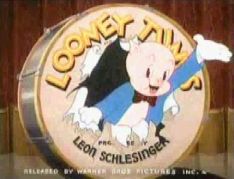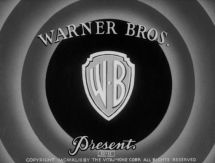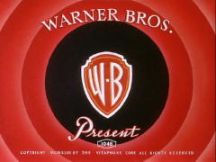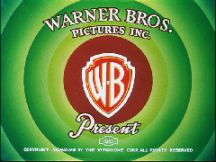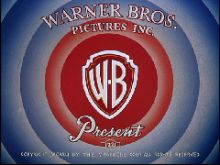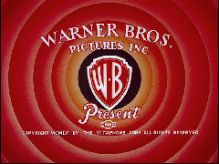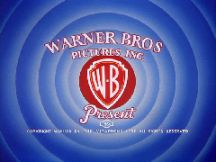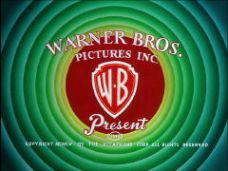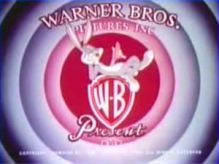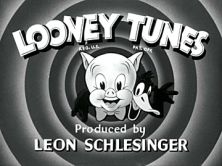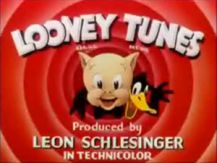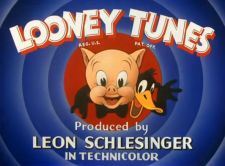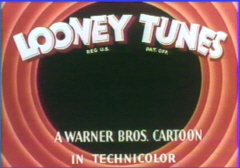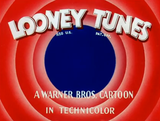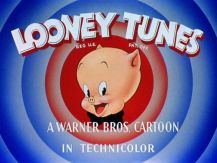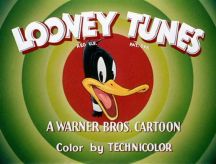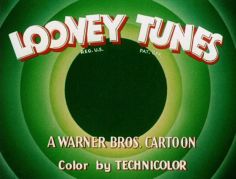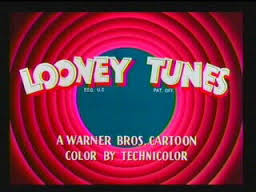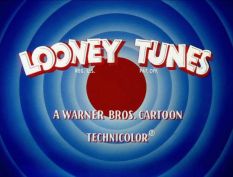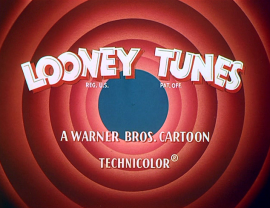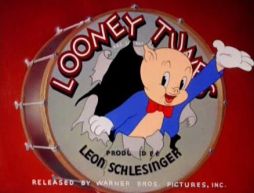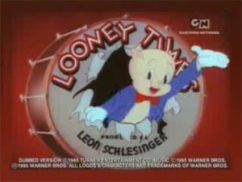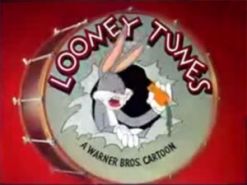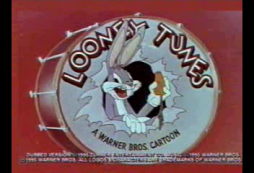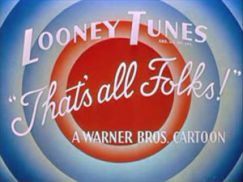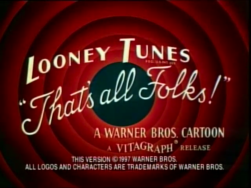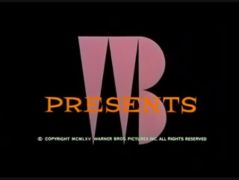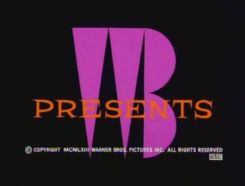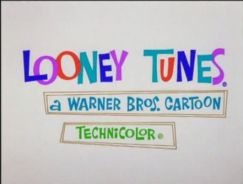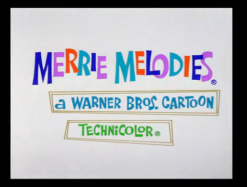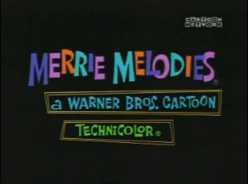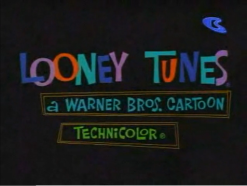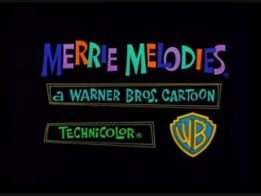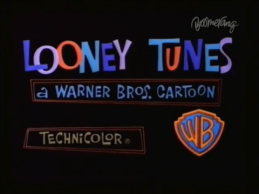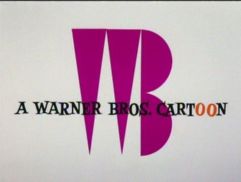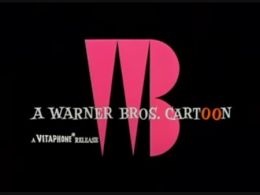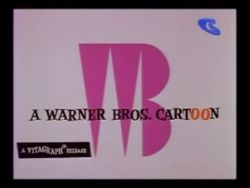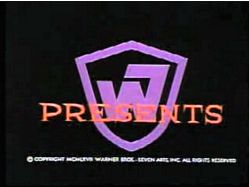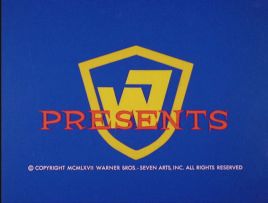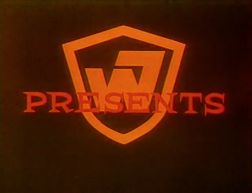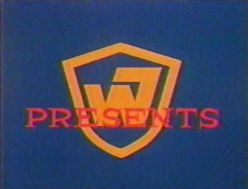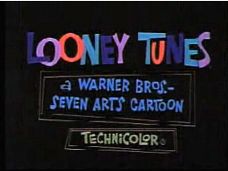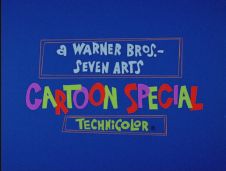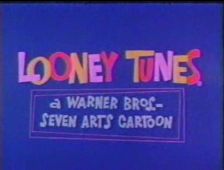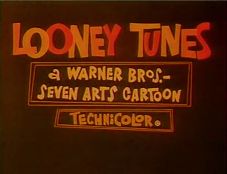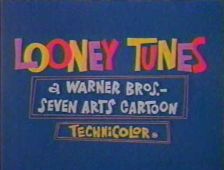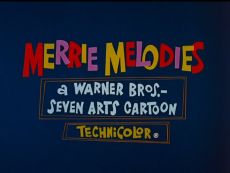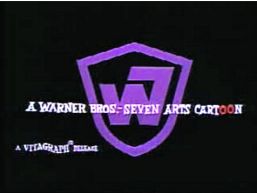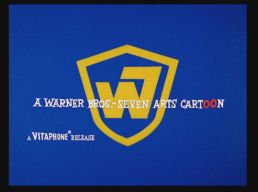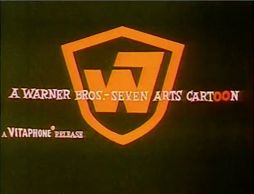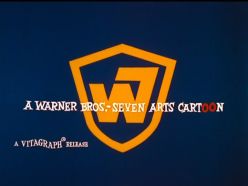Looney Tunes IDs
Jump to navigation
Jump to search
Logo descriptions and captures by Matt Williams, WileE2005, mr3urious, BluTheParrot, nevadabell, and D.L. Chandell
Additional Captures by gsn93
1st Logo
(April 19, 1930-August 13, 1932)
Nickname: “Bosko Titles I”
Studio Logo: On a gray (or black) background, the words "WARNER BROS. PICTURES, INC." are shown, and below that, "& THE VITAPHONE CORP." is shown in a much smaller font, with "VITAPHONE" using "electric" style letters. Below that is a very small WB shield, and in script, "Present". Behind it there is the drawing of a flag, "waving" so it looks like it is in three sections. On the first one, "WARNER BROS." appears, followed by the electric-letter "VITAPHONE" logo and on section three, "PICTURES". Below that is the copyright information.
Series Logo: A white sign in the middle has the words "LOONEY TUNES" and in black, "A HUGH HARMAN-RUDOLF ISING PRODUCTION" below that. Below the sign in small letters are the words "LEON SCHLESINGER, PRODUCER". Holding up the sign is Bosko, a Mickey Mouse-type character who was WB's current star at the time. Poking out from behind the sign and standing around the logo are stereotypical '30s cartoon animals (a bird, a goat, and a dog, to be exact).
Variants:
Closing Logo: Bosko peeks out from behind the left of a sign reading "A LOONEY TUNE" and emerges, along with a dog (the same dog from the series title card). Bosko holds out his hands and says "That's all, folks!", grinning in the end. The dog jumps and barks several times. Below it, in white, are the words "A HUGH HARMAN-RUDOLF ISING SOUND/MUSICAL CARTOON/PRODUCTION", and "Licensed under BRAY-HURD patents".
FX/SFX: No animation except for the closing. But the first cartoon, Sinkin' in the Bathtub, actually had an animated opening.
Music/Sounds: A Hot Time in the Old Town Tonight by Theodore Metz is the series theme. Starting with the 1931 short Bosko the Doughboy, the key and tempo of the theme is changed, and in the middle of it, the classic WB "trombone gobble" sound effect can be heard.
Availability: Rare, as Bosko shorts are pretty much no longer seen on TV due to their "ethnic offensiveness". A handful of cartoons featuring this logo are available on the Looney Tunes Golden Collection: Volume 6 DVD release. Many of them are now in the public domain, and several of them are on various online video websites. Some Bosko cartoons, however, replace this logo with the Sunset Productions copyright card and the 3rd Series Logo (see below), and often have a Guild Films "THE END" logo plastered over the closing card (with Bosko's "That's all, Folks!" and the dog barking heard underneath), but a few of them have the logo replaced with the early-1960s Seven Arts Television Looney Tunes closing variant. The original opening credits for Sinkin' in the Bathtub are available on the Disc 3 of the Looney Tunes Platinum Collection: Volume 2.
Editors' Note: A pretty basic but good start for the Looney Tunes series.
2nd Logo
(September 3, 1932-August 26, 1933)
Nickname: “Bosko Titles 2”
Studio Logo: Same as the previous logo.
Series Title: Similar to the previous, but this time the only animal is a bird, and helping Bosko hold up the sign is his girlfriend Honey.
Closing Logo: Same as the last closing logo, except the lettering on the sign is in a different font, and the "BRAY-HURD" text is in italics.
Later Closing Variant: The "BRAY-HURD" text is replaced with "Distributed by Warner Bros. Pictures Inc." in the same font.
FX/SFX: Still not enough animation.
Music/Sounds: The first two cartoons with this logo used the same music as the previous logo. After that, the theme was Whistle and Blow Your Blues Away, composed by Carmen Lombardo and Joseph Young.
Availability: Again, rare due to the reason listed above. A few cartoons with this logo are available on the Looney Tunes Golden Collection: Volume 6 DVD set.
Editors' Note: Same as the first logo, but seeing as the series was only a couple years old by then, it makes sense.
3rd Logo
(September 9, 1933-August 24, 1935)
Nickname: “The Buddy Titles”
Studio Logo: Again, same as the previous logo. However, from 1934-1935, the "WARNER BROS. PICTURES" line is shortened to only "WARNER BROS." with "PRODUCTIONS CORPORATION" underneath it, then the "& THE VITAPHONE CORPORATION" line.
Opening Logo: On a curtain backdrop to the right, WB's newest cartoon star, Buddy, appears, holding his right hand up Vanna White-style. On the upper left side of the screen, the words "LOONEY TUNES" appear, and below Buddy and the curtain are the words "Produced by LEON SCHLESINGER".
Early Opening Variant: For the first cartoons with this logo, “LOONEY TUNES” is on a sign on a fence with birds on it, and on the left, Buddy stands there, and on the right, his girlfriend named Cookie stands there in a hot pose. Under that is the Leon Schlesinger credit. However, the first Buddy cartoon, Buddy's Day Out, had Buddy carrying two flowers, and Cookie carrying Elmer, her baby brother into a buggy. They are accompanied by Happy, a dog.
Closing Logo: Same as the opening logo, except Buddy is animated saying "That’s all, Folks", and below the Leon Schlesinger credit are the words "Distributed by WARNER BROS. PICTURES, INC." But from 1934-1935, "WARNER BROS. PICTURES, INC." is changed to "WARNER BROS. PRODUCTIONS CORP."
Early Closing Variant: Same as the early series logo, except with Buddy appearing from behind the fence saying “That’s all, folks!”, with an iris out on the logo.
Availability: Near extinction, as cartoons from this period are currently not rerun on TV anywhere. This was also attached to Sunset Productions' re-issue prints of the Bosko cartoons. Several cartoons featuring this logo are available on the Looney Tunes Golden Collection: Volume 6 DVD release.
Editors' Note: Similar to the previous logo, but it could be given that in the early days of theatrical sound cartoons, they didn't really get as ambitious with their logos until later on. This does have a somewhat bad reputation for appearing on one of the least popular eras of the Warner Bros. cartoons.
4th Logo
(September 14, 1935-September 12, 1936)
Nickname: “The Beans Gang Titles”, "The WB Porthole"
Studio Logo: At the top of the screen, curved, the word "VITAPHONE" appears in the same electric letter font used previously, and on the very bottom is the word "Presents" in script, followed by the copyright info. The background is the same as the later variant from the last logo. And the WB shield's most famous role is cemented: it zooms in from a long distance in the center of the screen to a huge size.
Closing Logo: A black screen with "LOONEY TUNES" curved at the top-left with "PRODUCED BY LEON SCHLESINGER" on the bottom-right. "RELEASED BY WARNER BROS. PRODUCTIONS CORP." is at the very bottom, and at the center, the world-famous "That's all Folks!" logo writes itself on.
Early Closing Variant: Same as the closing later variant of the previous logo.
FX/SFX: The "writing on" of the "That's all Folks!", the infamous "zooming shield".
Music/Sounds: Same as the previous logo, still at a faster pace. There were a few different variations of the theme.
Availability: Can be seen on a few Beans Gang LT shorts and the early Porky shorts if ever rerun. TV reruns often have them colorized (but not for DVD releases). This was also attached to Sunset Productions' re-issue prints of the Beans Gang shorts and the early Porky shorts (with the studio logo replaced with the Sunset Productions copyright screen). The early closing is seen on A Cartoonist's Nightmare, Hollywood Capers and Gold Diggers of '49.
Editors' Note: The classic zooming WB shield adds more to the then-coming distinct feel of the classic Warner Bros. cartoons, but it still has a few ways to go.
5th Logo
(October 3, 1936-September 11, 1937)
Nickname: “Fat Porky Pig”
Studio Logo: Against a background of musical notes, the WB shield zooms in with "VITAPHONE" above and "Presents" below. Copyright info is shown below.
Series Title: "LOONEY TUNES" is curved near the top against a background of musical notes with "PRODUCED BY LEON SCHESINGER" at the bottom. Porky Pig’s head is in the center.
Closing Logo: The same black "That's all Folks!" screen as the previous logo, but with a slightly different font.
Nickname: "Porky on Musical Notes," “Porky in a Drum”, "Porky On The Fence"
Studio Logo: Same as the previous logo, but now the cartoon's production number appears underneath "Presents" and over the copyright notice. Beginning in 1939, "VITAPHONE" is replaced with "WARNER BROS.", and "Presents" is replaced with "Present."
Series Title: "LOONEY TUNES" in a font close to its' distinctive look is curved near the top against a background of musical notes with "PRODUCED BY LEON SCHESINGER" at the bottom. Porky Pig, now in his redesigned form by Bob Clampett, does the following poses listed.
Closing Logo: Porky Pig's place in world history is assured as he breaks out of a drum saying his famous "T-T-T-Th-Th-Th-That's all Folks!" line. On the top of the drum is "LOONEY TUNES" and below it is "PRODUCED BY LEON SCHLESINGER". At the bottom is "RELEASED BY WARNER BROS. PRODUCTIONS CORP.". Behind the drum is a curtain background. In 1938, starting with Porky's Spring Planting, "RELEASED BY WARNER BROS. PRODUCTIONS CORP." is changed to "RELEASED BY WARNER BROS. PICTURES INC.". In 1939, starting with Porky's Hotel, a redesigned version of Porky Pig comes out of the drum. On Meet John Doughboy (1941), Porky doesn't blink.
Colorized Variants:
FX/SFX: The "zooming shield".
Cheesy Factor: Same as the 4th logo.
Music/Sounds: The distinctive Looney Tunes theme, The Merry-Go-Round Broke Down, is introduced, composed by Cliff Friend and Dave Franklin, and arranged by Carl Stalling. An abridged version at a different key is also used for the closing theme.
Music/Sound Variants:
Availability: Seen on many '30s and early '40s Porky Pig cartoons, though this logo is mostly colorized (except for DVD releases). They are almost never rerun on Boomerang these days, but many can be found on the Boomerang streaming service. Although the opening titles ended on September 5, 1942, the closing titles continued to be used on black and white cartoons until December 11, 1943 with Puss n Booty.
Editors' Note: There are now many classic and distinctive elements to the opening and closing logos, i.e. the use of "The Merry-Go-Round Broke Down" as the theme music, the WB shield zooming in (with appropriate sound effect) and Porky breaking out of a drum to deliver his famous "That's all, folks!" stutter.
7th Logo
(October 3, 1942-July 18, 1964) Nicknames: “The Bullseye (Circles)”, “The Concentric Circles”
Studio Logo: Similar to the previous logos, only now the famous "Circles/Bullseye" backdrop that has become a trademark of Warner Bros. is in place. In 1944, below the "WARNER BROS.", "PICTURES INC." is added.
Series Title: Above the "bullseye" and on the same background, "LOONEY TUNES" appears in its now-distinctive font. Below it is "Produced by LEON SCHLESINGER". In 1944, this was changed to “Produced by WARNER BROS. CARTOONS” and then "A WARNER BROS. CARTOON". On color cartoons with this logo, it says “IN TECHNICOLOR” (1942-1948), "IN CINECOLOR" (some 1947-1949 cartoons only), “Color by TECHNICOLOR” (1948-1956) or “TECHNICOLOR” (1956-1964).
Closing Logo: It started with the "That's all Folks!" script being written out, and then "LOONEY TUNES" appearing at the top, curved as in the "black screen" logo, with "A WARNER BROS. CARTOON" appearing word-by-word near the bottom. From 1960-1964, the titles bore an additional legend: “A VITAGRAPH RELEASE”. The background was the circles/bullseye used in the Studio Logo. The colors of the backdrop vary by year, but a list of the colors would be too long to put here (though starting in late 1959, dark red rings would be used for the remainder of this logo's run.)
FX/SFX: The "zooming shield", the "That's all Folks!" closing animation.
Music/Sounds: The Merry-Go-Round Broke Down is still used during this period. In 1945, this theme is shortened somewhat.
Music/Sound Variants: Many. Here's a listing:
Availability: Rare; can be seen on many classic Looney Tunes shorts being rerun on Boomerang (they are currently not being run on Cartoon Network or any other easily-accessible channels.) It also can be found on the Looney Tunes Golden Collection and Looney Tunes Super Stars DVDs and Looney Tunes Platinum Collection Blu-ray sets from Warner Home Video, and on Boomerang's streaming service. This logo was used on nearly five hundred classic Looney Tunes shorts, including Rabbit of Seville and False Hare, among many others.
Nicknames: “The Abstract WB,” "The New-Style Graphics Opening," "The DePatie-Freleng WB Logo," "The Rudy Larriva WB Logo"
Series Title: Two lines from the center of the screen swirl around and then slide away to reveal a strange series logo. On the top is "LOONEY TUNES" or "MERRIE MELODIES" in a weird multi-colored font and on the bottom-right "A WARNER BROS. CARTOON" appears in a rectangle in a similar single-colored font. Below the rectangle is the word "TECHNICOLOR". On 1965-1967 releases, a bannerless WB shield was seen to the right of "TECHNICOLOR." The lines then come back, slide back into each other, wiping away the text, and then become the four lines from the beginning, "swirling" away into the blackness.
Variants:
FX/SFX: The "line" animations, the "WB" appearing, the closing text "wiping" on and the "OO" animation. Lots more animation now than before.
Music/Sounds: A weird, atonal '60s version of The Merry-Go-Round Broke Down, arranged by William Lava, with various musical effects accompanying the line animations (most notably with WB shield-like guitar "twangs" accompanying the swirling lines zooming in and out). Unlike the pre-1964 logos, music no longer differs to each cartoon series, and has become somewhat standardized. The first three shorts using this logo mixed the zooming sound from the 1955-1964 LT theme with the zooming sound from this logo's theme and a cymbal crash was heard when the lines stopped zooming. The end titles originally used Big Ben chiming instead of music, and then a bicycle horn honking for the "OO" animation. Starting in 1964 with Pancho's Hideaway (the first LT short produced by DePatie-Freleng), the 1955 zoom sound and the cymbal clash were dropped from the opening theme, and the end titles began using an abridged version of the opening theme music, with the "OO" animation synchronized with the theme. On cartoons produced in 1967 with this logo sequence, a brief audio mistake is heard at the very end of the opening theme (as if a small snippet of different music is heard very briefly.)
Music/Sounds Trivia: Apparently there was a jazzy rearrangement version of Merrily We Roll Along made for this logo, composed by Milt Franklyn. It was never used, because around this time Franklyn unfortunately died of a heart attack in the middle of composing the score for the 1962 Tweety cartoon The Jet Cage. The recordings of Milt Franklyn's versions can be found on the Looney Tunes Golden Collection: Volume 5 DVD set.
Editors' Note: A major mood whiplash from the last logos, obviously due to change being in the wind for the Warner Bros. cartoons. The fact that this logo was mostly used on (and associated with) DePatie-Freleng and Format Films's noticeably lower-budget Warner Bros. cartoons (usually featuring either Speedy Gonzales and Daffy Duck or the Road Runner and Wile E. Coyote) doesn't help things either, due to the significantly lower quality compared to the previous WB cartoons. Despite this, it fits pretty well with its debut on Now Hear This.
9th Logo
FX/SFX: The lines, the wipe, the "OO", the W7 trace.
Music/Sounds: A newer variation of the same bizarre music used last time, which is generally less annoying, but stranger-sounding in most cases.
Music/Sound Variants: Here's a listing:
Availability: Near extinction; the original Looney Tunes/Merrie Melodies cartoon output was coming to a stop by this time. It is still saved on shorts of the period, but because many of them do not feature main/popular Looney Tunes characters (such as Sylvester or the Road Runner) and are of a more inferior quality compared to the 1940s and 1950s shorts, they are generally not shown when Looney Tunes are rerun on Boomerang; however, as of August 1, 2016, three cartoons with this logo (Fiesta Fiasco, Hippydrome Tiger and 3 Ring Wing Ding) have been aired on Boomerang, making it the first time in eleven years this logo has appeared on American TV, but have almost never been rerun since. The Norman Normal variant is available, fully restored, on the Looney Tunes Golden Collection: Volume 6 DVD release, the standard variant can be seen on the two "Bunny and Claude" shorts on the Looney Tunes Super Stars: Porky & Friends - Hilarious Ham DVD, and the early variant (unrestored) can be found on the 1967 short Merlin the Magic Mouse on the Looney Tunes Mouse Chronicles DVD/Blu-ray set. The Door variant has been restored on the Looney Tunes Platinum Collection: Volume One Blu-ray set.
Additional Captures by gsn93
Editions by WileE2005
Videos by CenaTv2
1st Logo
(April 19, 1930-August 13, 1932)
Nickname: “Bosko Titles I”
Studio Logo: On a gray (or black) background, the words "WARNER BROS. PICTURES, INC." are shown, and below that, "& THE VITAPHONE CORP." is shown in a much smaller font, with "VITAPHONE" using "electric" style letters. Below that is a very small WB shield, and in script, "Present". Behind it there is the drawing of a flag, "waving" so it looks like it is in three sections. On the first one, "WARNER BROS." appears, followed by the electric-letter "VITAPHONE" logo and on section three, "PICTURES". Below that is the copyright information.
Series Logo: A white sign in the middle has the words "LOONEY TUNES" and in black, "A HUGH HARMAN-RUDOLF ISING PRODUCTION" below that. Below the sign in small letters are the words "LEON SCHLESINGER, PRODUCER". Holding up the sign is Bosko, a Mickey Mouse-type character who was WB's current star at the time. Poking out from behind the sign and standing around the logo are stereotypical '30s cartoon animals (a bird, a goat, and a dog, to be exact).
Variants:
- For the first few cartoons with this logo, it is altogether in one card. Under “LOONEY TUNES”, it reads “A HUGH HARMAN-RUDOLF ISING MUSICAL CARTOON”. Leon Schlesinger was also credited back then as “ASSOCIATE PRODUCER”. Above the sign is the WB and Vitaphone text without the WB shield. Also, an early animated Bosko is used. The very first cartoon, Sinkin' in the Bathtub, had this card animated (in fact due to the sound effects accompanying A Hot Time in the Old Town Tonight), but without the WB/Vitaphone text above. Under "LOONEY TUNES", it reads "A HUGH HARMAN & RUDOLPH ISING SOUND CARTOON". The later title card was first used in Bosko the Doughboy.
- In later cartoons, there would be no WB/Vitaphone text above the white sign.
- The very first cartoon, Sinkin' in the Bathtub, was preceded by the standard Vitaphone Varieties opening logo, which reads "Presented by VITAPHONE, a subsidiary of WARNER BROTHERS PICTURES, INC." with the 1923-1929 WB shield logo under it. Below the WB shield are the words "Produced with WESTERN ELECTRIC apparatus".
- The end title's credit font and arrangement differ from short to short, as well as Bosko's tone (earlier shorts had him voiced by Carman Maxwell, where starting in 1930, Johnny Murray started voicing him in a more high-pitched voice).
Closing Logo: Bosko peeks out from behind the left of a sign reading "A LOONEY TUNE" and emerges, along with a dog (the same dog from the series title card). Bosko holds out his hands and says "That's all, folks!", grinning in the end. The dog jumps and barks several times. Below it, in white, are the words "A HUGH HARMAN-RUDOLF ISING SOUND/MUSICAL CARTOON/PRODUCTION", and "Licensed under BRAY-HURD patents".
FX/SFX: No animation except for the closing. But the first cartoon, Sinkin' in the Bathtub, actually had an animated opening.
Music/Sounds: A Hot Time in the Old Town Tonight by Theodore Metz is the series theme. Starting with the 1931 short Bosko the Doughboy, the key and tempo of the theme is changed, and in the middle of it, the classic WB "trombone gobble" sound effect can be heard.
Availability: Rare, as Bosko shorts are pretty much no longer seen on TV due to their "ethnic offensiveness". A handful of cartoons featuring this logo are available on the Looney Tunes Golden Collection: Volume 6 DVD release. Many of them are now in the public domain, and several of them are on various online video websites. Some Bosko cartoons, however, replace this logo with the Sunset Productions copyright card and the 3rd Series Logo (see below), and often have a Guild Films "THE END" logo plastered over the closing card (with Bosko's "That's all, Folks!" and the dog barking heard underneath), but a few of them have the logo replaced with the early-1960s Seven Arts Television Looney Tunes closing variant. The original opening credits for Sinkin' in the Bathtub are available on the Disc 3 of the Looney Tunes Platinum Collection: Volume 2.
Editors' Note: A pretty basic but good start for the Looney Tunes series.
2nd Logo
(September 3, 1932-August 26, 1933)
Nickname: “Bosko Titles 2”
Studio Logo: Same as the previous logo.
Series Title: Similar to the previous, but this time the only animal is a bird, and helping Bosko hold up the sign is his girlfriend Honey.
Closing Logo: Same as the last closing logo, except the lettering on the sign is in a different font, and the "BRAY-HURD" text is in italics.
Later Closing Variant: The "BRAY-HURD" text is replaced with "Distributed by Warner Bros. Pictures Inc." in the same font.
FX/SFX: Still not enough animation.
Music/Sounds: The first two cartoons with this logo used the same music as the previous logo. After that, the theme was Whistle and Blow Your Blues Away, composed by Carmen Lombardo and Joseph Young.
Availability: Again, rare due to the reason listed above. A few cartoons with this logo are available on the Looney Tunes Golden Collection: Volume 6 DVD set.
Editors' Note: Same as the first logo, but seeing as the series was only a couple years old by then, it makes sense.
3rd Logo
(September 9, 1933-August 24, 1935)
Nickname: “The Buddy Titles”
Studio Logo: Again, same as the previous logo. However, from 1934-1935, the "WARNER BROS. PICTURES" line is shortened to only "WARNER BROS." with "PRODUCTIONS CORPORATION" underneath it, then the "& THE VITAPHONE CORPORATION" line.
Later Studio Logo: The standard Warner Bros. Productions Corp. logo takes place on a background similar to a ship's porthole.
Opening Logo: On a curtain backdrop to the right, WB's newest cartoon star, Buddy, appears, holding his right hand up Vanna White-style. On the upper left side of the screen, the words "LOONEY TUNES" appear, and below Buddy and the curtain are the words "Produced by LEON SCHLESINGER".
Early Opening Variant: For the first cartoons with this logo, “LOONEY TUNES” is on a sign on a fence with birds on it, and on the left, Buddy stands there, and on the right, his girlfriend named Cookie stands there in a hot pose. Under that is the Leon Schlesinger credit. However, the first Buddy cartoon, Buddy's Day Out, had Buddy carrying two flowers, and Cookie carrying Elmer, her baby brother into a buggy. They are accompanied by Happy, a dog.
Closing Logo: Same as the opening logo, except Buddy is animated saying "That’s all, Folks", and below the Leon Schlesinger credit are the words "Distributed by WARNER BROS. PICTURES, INC." But from 1934-1935, "WARNER BROS. PICTURES, INC." is changed to "WARNER BROS. PRODUCTIONS CORP."
Early Closing Variant: Same as the early series logo, except with Buddy appearing from behind the fence saying “That’s all, folks!”, with an iris out on the logo.
Later Closing Variant: A cat named Beans is shown instead of Buddy. Beans says "That's all, folks!" to the cartoon's closing theme.
FX/SFX: As with LT Logos 1 and 2, there's not much animation. However, that was soon to change.
Music/Sounds: A very bright, over-emphatically child-like arrangement keeping with theme of the family vibe of the title cards.
Music/Sounds Variants:
FX/SFX: As with LT Logos 1 and 2, there's not much animation. However, that was soon to change.
Music/Sounds: A very bright, over-emphatically child-like arrangement keeping with theme of the family vibe of the title cards.
Music/Sounds Variants:
- For later cartoons, the theme is faster-paced.
- On the second cartoon Buddy's Beer Garden, it use the music from the previous logo. This is most likely because Buddy's Beer Garden was actually the first Buddy cartoon produced, but the second to be released.
Availability: Near extinction, as cartoons from this period are currently not rerun on TV anywhere. This was also attached to Sunset Productions' re-issue prints of the Bosko cartoons. Several cartoons featuring this logo are available on the Looney Tunes Golden Collection: Volume 6 DVD release.
Editors' Note: Similar to the previous logo, but it could be given that in the early days of theatrical sound cartoons, they didn't really get as ambitious with their logos until later on. This does have a somewhat bad reputation for appearing on one of the least popular eras of the Warner Bros. cartoons.
4th Logo
(September 14, 1935-September 12, 1936)
Nickname: “The Beans Gang Titles”, "The WB Porthole"
Studio Logo: At the top of the screen, curved, the word "VITAPHONE" appears in the same electric letter font used previously, and on the very bottom is the word "Presents" in script, followed by the copyright info. The background is the same as the later variant from the last logo. And the WB shield's most famous role is cemented: it zooms in from a long distance in the center of the screen to a huge size.
Early Studio Logo: Same as the later variant of the previous logo.
Series Title: Using the same porthole background as the studio logo, in the center, "LOONEY TUNES" appears. The Beans Gang, WB's current stars, which consists of (going counterclockwise starting at the top right) Beans, his girlfriend, Oliver Owl, and Porky Pig, appear around it. Below "LOONEY TUNES", "PRODUCED BY LEON SCHLESINGER" appears.
Variants:
Series Title: Using the same porthole background as the studio logo, in the center, "LOONEY TUNES" appears. The Beans Gang, WB's current stars, which consists of (going counterclockwise starting at the top right) Beans, his girlfriend, Oliver Owl, and Porky Pig, appear around it. Below "LOONEY TUNES", "PRODUCED BY LEON SCHLESINGER" appears.
Variants:
* Some cartoons may be colorized mainly for TV reruns, but not for DVD releases.
Closing Logo: A black screen with "LOONEY TUNES" curved at the top-left with "PRODUCED BY LEON SCHLESINGER" on the bottom-right. "RELEASED BY WARNER BROS. PRODUCTIONS CORP." is at the very bottom, and at the center, the world-famous "That's all Folks!" logo writes itself on.
Early Closing Variant: Same as the closing later variant of the previous logo.
FX/SFX: The "writing on" of the "That's all Folks!", the infamous "zooming shield".
Music/Sounds: Same as the previous logo, still at a faster pace. There were a few different variations of the theme.
Availability: Can be seen on a few Beans Gang LT shorts and the early Porky shorts if ever rerun. TV reruns often have them colorized (but not for DVD releases). This was also attached to Sunset Productions' re-issue prints of the Beans Gang shorts and the early Porky shorts (with the studio logo replaced with the Sunset Productions copyright screen). The early closing is seen on A Cartoonist's Nightmare, Hollywood Capers and Gold Diggers of '49.
Editors' Note: The classic zooming WB shield adds more to the then-coming distinct feel of the classic Warner Bros. cartoons, but it still has a few ways to go.
5th Logo
(October 3, 1936-September 11, 1937)
Nickname: “Fat Porky Pig”
Studio Logo: Against a background of musical notes, the WB shield zooms in with "VITAPHONE" above and "Presents" below. Copyright info is shown below.
Series Title: "LOONEY TUNES" is curved near the top against a background of musical notes with "PRODUCED BY LEON SCHESINGER" at the bottom. Porky Pig’s head is in the center.
Closing Logo: The same black "That's all Folks!" screen as the previous logo, but with a slightly different font.
Closing Logo Variants:
* On the ending of Milk and Money (1936), Hank the Horsefly hits Mr. Viper in the rear, making him dizzy and his hat fly off. Porky's Poppa then holds up Porky, which pulls down a black screen, obscuring them, but not Mr. Viper. The same animation as normal plays over the dizzied Mr. Viper, whose hat returns.
* On Porky's Duck Hunt, an end title gag is used. The font is same as the last one, but Daffy jumping and dancing across the end title card, which has all text already formed and is on a gray background.
FX/SFX: The "zooming shield".
Music/Sounds: The first two cartoons using this logo featured the same music from the previous logo. After which, beginning with Porky in the North Woods, a new theme by M.K. Jerome known as the Porky Signature is used. There were many variations on this opening theme. In mid-1937, the shield has its sound effect: the famous "twanging" noise created by Treg Brown and produced using a dobro/steel guitar. A closing variation of the theme is first used on Porky's Badtime Story.
Availability: Still saved on Porky Pig cartoons from the period, though mostly colorized on TV reruns (but not for DVD releases). The Porky's Duck Hunt variant was last seen on TV back in the early 2000s.
Editors' Note: Now that Porky Pig was the solo star of the Looney Tunes, these cartoons' logo sequences are starting to take on some more familiar traits.
6th Logo
(October 9, 1937-September 5, 1942 [Opening], December 11, 1943 [Closing])
FX/SFX: The "zooming shield".
Music/Sounds: The first two cartoons using this logo featured the same music from the previous logo. After which, beginning with Porky in the North Woods, a new theme by M.K. Jerome known as the Porky Signature is used. There were many variations on this opening theme. In mid-1937, the shield has its sound effect: the famous "twanging" noise created by Treg Brown and produced using a dobro/steel guitar. A closing variation of the theme is first used on Porky's Badtime Story.
Availability: Still saved on Porky Pig cartoons from the period, though mostly colorized on TV reruns (but not for DVD releases). The Porky's Duck Hunt variant was last seen on TV back in the early 2000s.
Editors' Note: Now that Porky Pig was the solo star of the Looney Tunes, these cartoons' logo sequences are starting to take on some more familiar traits.
6th Logo
(October 9, 1937-September 5, 1942 [Opening], December 11, 1943 [Closing])
Nickname: "Porky on Musical Notes," “Porky in a Drum”, "Porky On The Fence"
Studio Logo: Same as the previous logo, but now the cartoon's production number appears underneath "Presents" and over the copyright notice. Beginning in 1939, "VITAPHONE" is replaced with "WARNER BROS.", and "Presents" is replaced with "Present."
Series Title: "LOONEY TUNES" in a font close to its' distinctive look is curved near the top against a background of musical notes with "PRODUCED BY LEON SCHESINGER" at the bottom. Porky Pig, now in his redesigned form by Bob Clampett, does the following poses listed.
- (October 9, 1937-August 27, 1938) Porky is on the right side facing left with arms stretched out.
- (September 24, 1938-August 5, 1939) Porky is in the center facing right with arms stretched out.
- (September 2, 1939-August 24, 1940) Porky is holding a hat.
- (September 21, 1940-August 30, 1941) Porky is seen sitting in an open drum.
(Between 1940 and 1941, two different versions of Porky are used, illustrating the evolution of the character.) - (September 20, 1941-September 5, 1942) Porky is sitting on a fence.
Closing Logo: Porky Pig's place in world history is assured as he breaks out of a drum saying his famous "T-T-T-Th-Th-Th-That's all Folks!" line. On the top of the drum is "LOONEY TUNES" and below it is "PRODUCED BY LEON SCHLESINGER". At the bottom is "RELEASED BY WARNER BROS. PRODUCTIONS CORP.". Behind the drum is a curtain background. In 1938, starting with Porky's Spring Planting, "RELEASED BY WARNER BROS. PRODUCTIONS CORP." is changed to "RELEASED BY WARNER BROS. PICTURES INC.". In 1939, starting with Porky's Hotel, a redesigned version of Porky Pig comes out of the drum. On Meet John Doughboy (1941), Porky doesn't blink.
- Some of the hand-colorized cartoons (mostly the public domain cartoons, colorized in the late 1960s) feature "fake" redrawn versions of the opening titles. One one hand-colorized variant, the WB shield simply fades in on the musical-note background instead of zooming in.
- On some 1940-1943 digital colorizations, the early (1937-1939) Porky Pig in a Drum closing is utilized instead of the correct version, due to an editing mistake in the colorization process. Some examples include A Coy Decoy, Daffy's Southern Exposure and Porky's Pig Feat.
FX/SFX: The "zooming shield".
Cheesy Factor: Same as the 4th logo.
Music/Sounds: The distinctive Looney Tunes theme, The Merry-Go-Round Broke Down, is introduced, composed by Cliff Friend and Dave Franklin, and arranged by Carl Stalling. An abridged version at a different key is also used for the closing theme.
Music/Sound Variants:
- October 1937-November 1938: Most well-known version of the opening theme from the early era, with lots of brass and strings. It also shows up on The Timid Toreador (December 21, 1940) in place of the November 1938 theme. Two closing theme variants were used, with the second one debuting in July 1938.
- November 1937-January 1938: Rare, sparsely modified opening theme variant used only on three cartoons. Closing theme is the same.
- November 1938-March 1941: Heavily modified opening theme that has a more "lighter" sound to it. Closing theme is the same as the early 1938 theme.
- March 1941: Specially-modified version for a one-shot cartoon called Joe Glow the Firefly, with a different key in the first section of the opening theme, said to be arranged by Milt Franklyn.
- March 1941-June 1945: Heavily modified opening and closing themes now at a faster tempo and with more brass, second most-well-known version.
- A few of the 1990s digital colorizations of these cartoons feature this logo with the 1936-1937 opening theme playing over the opening logo instead (the later version with the zooming noise at the beginning). This was not how the cartoons originally started, and was an error made during the colorizations. Such examples include The Henpecked Duck, Porky's Pastry Pirates, Porky's Midnight Matinee, We the Animals Squeak!, Porky's Cafe, Daffy's Southern Exposure and Slap-Happy Pappy. The ending titles, however, features the correct closing themes that they originally utilized.
- The digitally-colorized versions of A Coy Decoy and The Impatient Patient open with the November 1938 opening theme, instead of the correct March 1941 opening theme (the latter has it sped-up to accommodate the running time of the opening titles.)
Availability: Seen on many '30s and early '40s Porky Pig cartoons, though this logo is mostly colorized (except for DVD releases). They are almost never rerun on Boomerang these days, but many can be found on the Boomerang streaming service. Although the opening titles ended on September 5, 1942, the closing titles continued to be used on black and white cartoons until December 11, 1943 with Puss n Booty.
Editors' Note: There are now many classic and distinctive elements to the opening and closing logos, i.e. the use of "The Merry-Go-Round Broke Down" as the theme music, the WB shield zooming in (with appropriate sound effect) and Porky breaking out of a drum to deliver his famous "That's all, folks!" stutter.
7th Logo
(October 3, 1942-July 18, 1964) Nicknames: “The Bullseye (Circles)”, “The Concentric Circles”
Studio Logo: Similar to the previous logos, only now the famous "Circles/Bullseye" backdrop that has become a trademark of Warner Bros. is in place. In 1944, below the "WARNER BROS.", "PICTURES INC." is added.
Series Title: Above the "bullseye" and on the same background, "LOONEY TUNES" appears in its now-distinctive font. Below it is "Produced by LEON SCHLESINGER". In 1944, this was changed to “Produced by WARNER BROS. CARTOONS” and then "A WARNER BROS. CARTOON". On color cartoons with this logo, it says “IN TECHNICOLOR” (1942-1948), "IN CINECOLOR" (some 1947-1949 cartoons only), “Color by TECHNICOLOR” (1948-1956) or “TECHNICOLOR” (1956-1964).
Closing Logo: It started with the "That's all Folks!" script being written out, and then "LOONEY TUNES" appearing at the top, curved as in the "black screen" logo, with "A WARNER BROS. CARTOON" appearing word-by-word near the bottom. From 1960-1964, the titles bore an additional legend: “A VITAGRAPH RELEASE”. The background was the circles/bullseye used in the Studio Logo. The colors of the backdrop vary by year, but a list of the colors would be too long to put here (though starting in late 1959, dark red rings would be used for the remainder of this logo's run.)
Early Closing Logo: Until 1946, the Porky in a Drum closing was used on a red background; however, the Bugs Bunny cartoons Hare Tonic (1945) and Baseball Bugs (1946) have a variant where Bugs broke the drum and said "And that's the end!" while sitting in the open drum and munching on a carrot. Starting in 1944, the "LEON SCHLESINGER" text was changed to "PRODUCED BY WARNER BROS. CARTOONS INC." and then "A WARNER BROS. CARTOON".
Early Variant: The very first two cartoons with the logo (The Hep Cat and The Daffy Duckaroo, the former being re-released as Blue Ribbon Merrie Melodies) had the WB shield logo slightly bigger.
Variants: There were many variations to this logo, and here are some of them:
Variants: There were many variations to this logo, and here are some of them:
- The most famous one of these, with Bugs Bunny relaxing on top of the shield as it zooms in. He chomps on his carrot for a few seconds, looks angry at the "camera", and then pulls down (like a window shade) the next logo, the Looney Tunes logo. This was primarily used from 1945 to 1948.
- The shield fades into a face (usually oversized, jaw open) of the featured character in the cartoon it's used in. This was used mostly on Bugs Bunny cartoons, although Daffy's head was used a few times as well, as well as Porky on at least one short.
- On the 1954 Bugs Bunny short Lumber Jack-Rabbit, the shield zooms way too far and then zooms back to its correct position (Like a yo-yo), as this was the first Bugs Bunny short to be released in 3D. (This was later reincorporated into the opening for The Looney Tunes Show in 2011.)
- Sometimes, one of the character's heads would be seen on the series logo. It is usually either Daffy Duck, Porky Pig, or both of them. (This was mainly common in the 1940s.)
- Some Looney Tunes were re-released as "Blue Ribbon" Merrie Melodies and lost their title cards. These re-releases kept the Looney Tunes music (first at the closing titles only and then the full opening sequence as well), so it is painfully easy to spot former Looney Tunes that were reissued as Merrie Melodies. Examples include A Bear for Punishment and House-Hunting Mice.
- In 1995, Turner Entertainment created the infamous "dubbed version" re-releases of the pre-1948 color LT and MM cartoons, which share the same end card ("Porky in a Drum" or the "Bullseye Circles" in either orange or red rings) with copyright text chyroned in below. Several of these are still seen on TV and the Looney Tunes Golden Collection DVDs.
- Similar re-release remastered prints were prepared by Warner Bros. in 1997-1998, but this time, utilizing the original correct closing title from the original short, with copyright text chyroned in below (reading "THIS VERSION" instead of "DUBBED VERSION.")
- A widescreen version exists. Probably this is due to cropping in widescreen of post-1953 cartoons on Looney Tunes Super Stars DVDs like Bugs Bunny: Hare Extraordinaire, Daffy Duck: Frustrated Fowl and Foghorn Leghorn: Barnyard Bigmouth. Click the link <a class="external" href="http://www.dohtem.com/bugs/wide/" rel="nofollow" target="_blank">here</a> for more information.
FX/SFX: The "zooming shield", the "That's all Folks!" closing animation.
Music/Sounds: The Merry-Go-Round Broke Down is still used during this period. In 1945, this theme is shortened somewhat.
Music/Sound Variants: Many. Here's a listing:
- October 1942–March 1945: Same as the version first used in 1941.
- May 1945–July 1946: Abridged opening theme, now dominated by brass and woodwinds, same closing theme as March 1941 (except for Acrobatty Bunny).
- July 1946–June 1955: Abridged themes. Heavily modified opening and closing themes done in a "goofy" manner, most well-known version of the abridged opening theme. The closing theme is noticeably more brassy. Was still used for the Blue Ribbon reissues of cartoons originally released up to 1955. The opening version also accidentally shows up on Boston Quackie (June 22, 1957) in place of the May 1955 theme. The same happens on the TV print of the 1961 cartoon, Prince Violent (renamed "Prince Varmit" on that print).
- May 1955–July 1964: Heavily modified opening and closing themes, this time arranged by Milt Franklyn, with the zooming sound effect sounding like it was produced on an electric guitar. Sparsely used for Blue Ribbon reissues.
- In 1968, Warner Bros. colorized many of its black-and-white cartoons for television. The 1972 and 1980 prints of these shorts plastered its opening WB shield and closing IDs with the more contemporary "bullseye" design (in most cases taken from the 1956 short Deduce, You Say), but the original audio remained intact. As a result, you could still hear the drum breaking open and Porky Pig saying "Th-th-that's all, folks!" at the end of the cartoons, but you couldn't see him. In some cases, the "That's all Folks!" screen would then fade to the 1972 "Big \\' " closing "Distributed by Warner Bros." logo. Usually on the opening titles, the second half of the opening theme would be heard, but some redrawn titles like Wholly Smoke and An Ill Wind use the full-length opening theme.
- On the French language version of Baseball Bugs on the Looney Tunes Golden Collection Volume One DVD release, it includes the audio when Porky Pig say That's all Folks at the end, while the variant when Bugs is in the drum / munching on the carrot and not Porky Pig. It must been a plastering error on the Golden Collection Volume One release.
- On Kitty Kornered, the closing title has Merrily We Roll Along playing instead.
Availability: Rare; can be seen on many classic Looney Tunes shorts being rerun on Boomerang (they are currently not being run on Cartoon Network or any other easily-accessible channels.) It also can be found on the Looney Tunes Golden Collection and Looney Tunes Super Stars DVDs and Looney Tunes Platinum Collection Blu-ray sets from Warner Home Video, and on Boomerang's streaming service. This logo was used on nearly five hundred classic Looney Tunes shorts, including Rabbit of Seville and False Hare, among many others.
Editors' Note: This is a very famous and well-liked logo. It's bound to be very memorable to anyone growing up watching the Warner Bros. cartoons, in theaters or on television.
8th Logo
(April 27, 1963, February 29, 1964, August 1, 1964–September 30, 1967)
Background: In 1962, when Warner Bros. Animation was nearing the end of its classic run of Looney Tunes, famed WB cartoon director Chuck Jones created a much different one-shot cartoon, Now Hear This, which was done in a very artistic, abstract, and stylized manner. Chuck Jones also designed new, modern opening and closing titles intended for this cartoon only that fit with the cartoon. However, Termite Terrace also wound up using this logo on their other one-shot cartoons afterward, which were also done in a somewhat stylized manner. In 1963, Warner Bros. Animation shut down, and former staff members David H. DePatie and Friz Freleng opened their own animation studio where Termite Terrace was originally housed. A year later, they began producing Looney Tunes cartoons for WB to continue the series, and made the following opening/closing titles the permanent logos for the classic WB cartoons. In 1967, former USMCR colonel William L. (Bill) Hendricks took over as a producer of the series as they reopening Warner Bros. Animation by the same year and redesigned the opening sequence. The studio closed in 1969.
NOTE: By this point, the Looney Tunes and Merrie Melodies logos are no longer distinctive to each series and are now somewhat standardized/interchangeable, so both the LT and MM series will be described for the post-1964 logos.
Nicknames: “The Abstract WB,” "The New-Style Graphics Opening," "The DePatie-Freleng WB Logo," "The Rudy Larriva WB Logo"
Studio Logo: Completely different from before. On a black background, several series of lines come from the center of the screen zooming and swirling, three purple, one orange, with two of the purple ones diagonal, one of the purple ones vertical, and the orange one horizontal. The orange line moves down and up as the purple lines disappear one-by-one and a purple abstract "WB", with the W made up of two triangles and the B made up of two semicircles, appears. The orange line turns into the word "PRESENTS" over the abstract WB while a copyright notice appears on the bottom.
Series Title: Two lines from the center of the screen swirl around and then slide away to reveal a strange series logo. On the top is "LOONEY TUNES" or "MERRIE MELODIES" in a weird multi-colored font and on the bottom-right "A WARNER BROS. CARTOON" appears in a rectangle in a similar single-colored font. Below the rectangle is the word "TECHNICOLOR". On 1965-1967 releases, a bannerless WB shield was seen to the right of "TECHNICOLOR." The lines then come back, slide back into each other, wiping away the text, and then become the four lines from the beginning, "swirling" away into the blackness.
Variants:
- For the first four cartoons with this logo, this text is on a white background with no WB shield. The line animation and the studio logo still appear on a black background. The first three shorts also feature a production number on the bottom of the screen, under the copyright notice on the studio logo.
- Starting with the 1966 release year, the line animation at the beginning is altered a bit.
- On the last couple of cartoons to feature this logo, a Warner Bros.-Seven Arts copyright appears on the bottom.
- The black background variant is known to exist without the shield, seen on cartoons produced in late 1964.
Closing Logo: The abstract WB appears piece-by-piece (in pairs starting in 1966), and "A WARNER BROS. CARTOON" is wiped onto the screen. When the wiping gets to the "OO" in "CARTOON", the Os turn red and "pop out" of the logo, then pop back into the logo, like two eyes doing a take. They do this action three times fast (1963-1965) or two times slowly (1966-1967). "N" is then wiped on and "A VITAPHONE RELEASE" (for Merrie Melodies, with "VITAPHONE" in the warbly font it's famous for.) or "A VITAGRAPH RELEASE" (for Looney Tunes, with "VITAGRAPH" curving up and down.) appears on the bottom left.
Early Closing Variant:
- For the first three cartoons with this logo, the logo/text is on a white background with no Vitaphone/Vitagraph credit.
- On Bartholomew Versus the Wheel (1963), the "OO" bounces up and down six times instead of the usual three.
- On Pancho's Hideaway (1964), it is similar to the early white background variant, but features "A VITAGRAPH RELEASE" in white text on a black parallelogram on the bottom left.
FX/SFX: The "line" animations, the "WB" appearing, the closing text "wiping" on and the "OO" animation. Lots more animation now than before.
Music/Sounds: A weird, atonal '60s version of The Merry-Go-Round Broke Down, arranged by William Lava, with various musical effects accompanying the line animations (most notably with WB shield-like guitar "twangs" accompanying the swirling lines zooming in and out). Unlike the pre-1964 logos, music no longer differs to each cartoon series, and has become somewhat standardized. The first three shorts using this logo mixed the zooming sound from the 1955-1964 LT theme with the zooming sound from this logo's theme and a cymbal crash was heard when the lines stopped zooming. The end titles originally used Big Ben chiming instead of music, and then a bicycle horn honking for the "OO" animation. Starting in 1964 with Pancho's Hideaway (the first LT short produced by DePatie-Freleng), the 1955 zoom sound and the cymbal clash were dropped from the opening theme, and the end titles began using an abridged version of the opening theme music, with the "OO" animation synchronized with the theme. On cartoons produced in 1967 with this logo sequence, a brief audio mistake is heard at the very end of the opening theme (as if a small snippet of different music is heard very briefly.)
Music/Sounds Trivia: Apparently there was a jazzy rearrangement version of Merrily We Roll Along made for this logo, composed by Milt Franklyn. It was never used, because around this time Franklyn unfortunately died of a heart attack in the middle of composing the score for the 1962 Tweety cartoon The Jet Cage. The recordings of Milt Franklyn's versions can be found on the Looney Tunes Golden Collection: Volume 5 DVD set.
Availability: Seen on Warner Bros. cartoons made by DePatie-Freleng and Format Films from 1964-1967 and still saved on the mid-1960s Road Runner and Daffy Duck shorts when reran on Boomerang and on its streaming service. A handful of cartoons with this logo, including the first three using this logo with the original white background variant (with Big Ben closing) can be found on later Looney Tunes Golden Collection DVD sets and Looney Tunes Super Stars DVDs (like Daffy Duck: Frustrated Fowl, Wile E. Coyote and Road Runner: Supergenius Hijinks and Porky Pig: Hilarious Ham).
Editors' Note: A major mood whiplash from the last logos, obviously due to change being in the wind for the Warner Bros. cartoons. The fact that this logo was mostly used on (and associated with) DePatie-Freleng and Format Films's noticeably lower-budget Warner Bros. cartoons (usually featuring either Speedy Gonzales and Daffy Duck or the Road Runner and Wile E. Coyote) doesn't help things either, due to the significantly lower quality compared to the previous WB cartoons. Despite this, it fits pretty well with its debut on Now Hear This.
9th Logo
(October 14, 1967-September 20, 1969)
Nicknames: “WB-7”, “W7,” "The Abstract W7", "Lucky Number 7 on WB Shield", "The Bill Hendricks WB Logo"
Studio Logo: The same as the previous logo, but the background is now blue, while the three purple lines are now yellow and the orange one is now more pinkish-red. The three yellow lines disappear at the same time, as the W7 logo "draws" itself (see the W7 film logo), and the shield appears around it. The horizontal line animation is the same, though “PRESENTS” is now more pinkish as well.
Series Logo: Again, same as last time, only the WB shield is absent. Both rectangles are now centered, and the middle one reads "A WARNER BROS.-SEVEN ARTS CARTOON".
Closing Logo: Same as the last logo, although the "A WARNER BROS. CARTOON" line is changed to add in the Seven Arts information and the abstract WB is replaced by the W7 logo, which merely "appears" at the beginning of the end title without any forming animation. The "OO" pops up and down three times fast now.
Variants:
Series Logo: Again, same as last time, only the WB shield is absent. Both rectangles are now centered, and the middle one reads "A WARNER BROS.-SEVEN ARTS CARTOON".
Closing Logo: Same as the last logo, although the "A WARNER BROS. CARTOON" line is changed to add in the Seven Arts information and the abstract WB is replaced by the W7 logo, which merely "appears" at the beginning of the end title without any forming animation. The "OO" pops up and down three times fast now.
Variants:
- For the first three cartoons with this logo, it reuses the color scheme of the “Abstract WB” logo, with a black background and purple W7 shield. This was only used in the 1967 release season.
- Shorts produced in 1969 remove the copyright info from the studio logo (instead moving it to the short's opening title card), and instead of the blue background remaining on before cutting to black at the end before the cartoon's opening titles appear, the logo now fades to black after the lines swirl away.
- The 1969 short Rabbit Stew and Rabbits Too had bad film deterioration to it on TV reruns in the 1990s and early 2000s, and the opening/closing logos had a dark red tint to them as a result. A remastered version with the proper color scheme has been spotted on Boomerang UK.
- On the 1968 short Norman Normal (based off the Paul Stookey song of the same name), the series logo is modified so on the top it has a rectangle reading "A WARNER BROS.-SEVEN ARTS" and underneath the rectangle is "CARTOON SPECIAL" in the LT/MM font. Underneath that is the "TECHNICOLOR" rectangle. The opening to the cartoon's theme music (Paul Stookey's Norman Normal) plays under this logo instead of having its own music, and at the end, the Norman Normal song also plays over the standard closing animation.
- Also on Norman Normal and on Hocus Pocus Pow-wow, the "W7" graphic is off-centered inside the shield during the studio logo.
- A rare still variant was seen on The Door (an independent animated short not produced by Warner Bros. Animation), which simply consisted of the yellow W-7 shield on a blue background. This was at the beginning of the short before the opening credits. No music was used here.
- Beginning some time in 1968, the Vitaphone/Vitagraph legend is switched around: Looney Tunes are now branded as "A VITAPHONE RELEASE," while Merrie Melodies get the Vitagraph equivalent.
- Some copies of the late-1960s redrawn-colorized Looney Tunes shorts from the late 1930s/early 1940s have a variation of this logo plastered onto the beginning, where it does not have the "TECHNICOLOR" rectangle on the bottom and has the second half of one of the 1935-1943 Looney Tunes opening themes playing under it, which does not fit with the logo at all. The ending has the Seven Arts closing plastered on, with either the ending of the cartoon's theme playing underneath (1935-1937) or the 1937-1943 closing themes, with Porky's "Th-the-th-the-th-the-that's all folks!" line coincidentally timed almost impeccably to match the bouncing of the "OO"s in the word "CARTOON". Some redrawn prints of Porky's Road Race with these logos use the 1967 opening theme music with the logo and the 1964 closing theme during the end titles.
FX/SFX: The lines, the wipe, the "OO", the W7 trace.
Music/Sounds: A newer variation of the same bizarre music used last time, which is generally less annoying, but stranger-sounding in most cases.
Music/Sound Variants: Here's a listing:
- October 1967-September 1969: Smaller amount of instruments and rather cheap-sounding electric guitar "twangs" during the line animation. The closing music is the same as the 1964 version.
- June 1968-August 1968: Heavily modified opening theme with electric guitar, horn and piano combo on the zooming line animations. Closing music is unchanged.
- March 1969: Opening theme sparsely modified, sounding like a hybrid of the October 1967 and June 1968 themes, only used on Fistic Mystic. Closing music is unchanged.
Availability: Near extinction; the original Looney Tunes/Merrie Melodies cartoon output was coming to a stop by this time. It is still saved on shorts of the period, but because many of them do not feature main/popular Looney Tunes characters (such as Sylvester or the Road Runner) and are of a more inferior quality compared to the 1940s and 1950s shorts, they are generally not shown when Looney Tunes are rerun on Boomerang; however, as of August 1, 2016, three cartoons with this logo (Fiesta Fiasco, Hippydrome Tiger and 3 Ring Wing Ding) have been aired on Boomerang, making it the first time in eleven years this logo has appeared on American TV, but have almost never been rerun since. The Norman Normal variant is available, fully restored, on the Looney Tunes Golden Collection: Volume 6 DVD release, the standard variant can be seen on the two "Bunny and Claude" shorts on the Looney Tunes Super Stars: Porky & Friends - Hilarious Ham DVD, and the early variant (unrestored) can be found on the 1967 short Merlin the Magic Mouse on the Looney Tunes Mouse Chronicles DVD/Blu-ray set. The Door variant has been restored on the Looney Tunes Platinum Collection: Volume One Blu-ray set.
Editors' Note: This logo also has a fairly bad reputation for appearing on one of the least popular eras of the Warner Bros. cartoons, when production moved back in-house at Warner Bros. Animation with a mostly-new crew and substantially smaller budgets, not to mention featuring very few of the popular classic characters (i.e. Daffy Duck and Speedy Gonzales) and mostly focusing on more newer, less-memorable characters (such as Cool Cat and Merlin the Magic Mouse). Overall, it carries the same problems from the previous logo, and it does not provide a fitting end to the Golden Age WB era.
<embed allowfullscreen="true" height="350" src="http://wikifoundrytools.com/wiki/closinglogos/widget/youtubevideo/a522e039716089b442f229186b59f51740a225c8" type="application/x-shockwave-flash" width="425" wmode="transparent"/>
